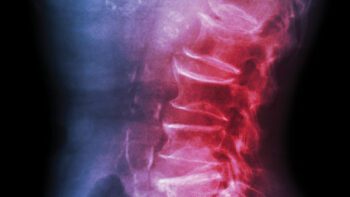
Spine surgery and fear can go hand-in-hand, but they don’t have to. In this piece from our recent Spine Health Journal, we speak with surgeons about it.
Perspective 1: Is spine surgery safe? Debunking the myths.
Steve Glassman, MD, Spine Surgeon & Neda F. Gilmartin, MD, Research Spine Fellow
Norton Leatherman Spine Center
The word surgery often causes anxiety and fear for patients, and this is particularly true when it comes to spine surgery. Many old beliefs and stigmas are still current today. At the top of the list is “can I be bedridden, paralyzed, or wheelchair bound?” Unfortunately, these misconceptions and outdated beliefs may get in the way of the best treatment that is available today.
When is ‘operation’ the right answer? This is a joint decision between the patient and the surgeon and is outside the topic of discussion here. When you and your surgeon discuss all the pros and the cons, you face the inevitable question of how safe the operation is, as well as what the outcome will be. We will address some of the common illusions regarding the safety of spinal surgery.
>>>> Grab all kinds of incredible surgeon interviews on Spine-Talks!
Before all else, spine surgery is an operation and as with any operation, there are risks of complications. Historic experience has led to valuable lessons, which we now see as advancements in medicine and surgery. Before the surgeon even starts operating, the anesthesiologists must put you to sleep. Anesthesiology was not always a routine step in surgery, but due to advancements in technology, patient safety during anesthesia has improved enormously. Technology has played an important role, facilitating delivery of anesthesia products in a highly controlled manner, and measuring depth of anesthesia with advanced non-invasive monitoring. These tight monitoring techniques and controls during anesthesia have made it a very safe part of surgery today.
Among the specific challenges faced in spine surgery is the need to work with bone and metal implants in very close proximity to vertebrae and the spinal cord without damaging them. To avoid issues of nerve damage and to ensure necessary correction of pressure on the nerves which may be the goal of surgery, emphasis has been put on technology to protect the nerves. These efforts have led to advanced neuro-monitoring techniques in the operating room to precisely monitor the nerves during the operation. These early warning systems against nerve injury increase safety and limit chances of reoperation.
The newest technological capabilities have brought advanced imaging such as CT and MRI scans into the operating room. Having these technologies available during spine surgery has increased surgical accuracy, providing navigation to guide an operation. Similar to a GPS in a car or on a phone, these systems track points of anatomy and display them on a monitor during the operation, to make sure the implants are placed correctly while avoiding damage to the nerves and muscles.
Thanks to these advancements and technological progress, spine surgery can also be performed minimally invasively with smaller incisions and less blood loss. Quicker return to daily activities may be possible, thanks in
part to improved imaging and neuro-monitoring technologies.
>>>>> 5 Ways to Improve and Preserve Spine Health
The advent of computer image guidance has allowed spine surgeons to advance their ability to refine surgical technique, increase the accuracy of spinal hardware placement and to reduce radiation exposure with the goal of better postoperative outcomes and patient satisfaction. In conclusion, we can assume that spine surgery like all surgeries harbors inherent risks. We also know that the necessity of these procedures, due to severe disability and the rightful desire for an improved quality of life, makes spine surgery a valuable option for some patients. Fortunately, technology has dramatically improved the safety of spinal surgery, and has largely eliminated some of the complications that generated myths of the past.
Perspective 2: Do patients need to fear spine surgery?
Todd J. Albert, MD, Surgeon-in-Chief Emeritus
Hospital for Special Surgery
Most patients who are recommended for spine surgery have had non-operative treatments, which have not been effective at alleviating symptoms and have had appropriate diagnostic imaging and examination that have led to a very specific diagnosis that can be treated effectively with spine surgery.
In the vast majority of cases, spine surgery is incredibly successful and is not to be feared. However, it is absolutely normal human behavior to be scared of surgery as we are often fearful of the unknown. Therefore, I certainly recommend gathering as much information as possible from your surgeon about the surgery, as it is important that you understand exactly what your diagnosis is and what the aim of surgery is. Appropriate expectations are paramount to a successful journey through surgery.
>>>> Spine Anatomy: What You Should Know
In most cases, the goal of surgery is to alleviate pressure on the nerve roots or spinal cord, and/or correct spinal deformity. We also perform surgery for tumors and trauma, which are usually needed on a more urgent or emergent basis.
Spine surgery has become increasingly safe and effective over the years with newer and less invasive techniques, advances in anesthesia, and spinal cord monitoring. Surgeons naturally are interested in ongoing improvement and therefore have become more experienced with newer techniques and the understanding of better methodologies for improving safety and efficacy.
Very commonly now patients are able to go through a spine surgery with modern techniques and avoid the use of aggressive narcotics for a period of time. Additionally, the patients often do not require significant strong medications or down time once at home. Very frequently after spine surgery, patients can begin their physical therapy, ambulation, and activities slowly in the hospital and progress at home to the point where they quickly reach independence.
>>>>> Ask the Expert: Research and the Patient
At the present time we have excellent prospective controlled studies showing the efficiency and excellent outcomes in patients treated with surgery for the following conditions:
- Lumbar Radiculopath (leg pain often with weakness or numbness due to pinched nerves or herniated discs in the lumbar spine)
- Spondylolisthesis with Stenosis (a slippage of one vertebrae on another with pinching of the nerve roots in the lumbar spine due to lack of space in the spinal canal)
- Cervical Radiculopathy and Myelopathy (pinching of the spinal cord and/or nerve roots in the neck causing difficulty with balance and coordination)
You should expect your surgeon will explain the risks and benefits of the surgery, and also generally how the surgery is performed and what to expect in your postoperative course while in the hospital and in the ensuing few weeks at home after surgery.
Once all of this information is gathered, you should be well equipped to go forward with spine surgery without an undue amount of fear or reticence about the surgery. If you think about the surgical goals and how you will feel on the other side of the surgery, with perhaps relief of the pain you have been experiencing or without the jeopardy of ongoing spinal cord compression, then the optimistic view of the outcome can be enjoyed.
Read more in our quarterly Spine Health Journal.



